low beam VOLVO S60 INSCRIPTION 2017 Owner´s Manual
[x] Cancel search | Manufacturer: VOLVO, Model Year: 2017, Model line: S60 INSCRIPTION, Model: VOLVO S60 INSCRIPTION 2017Pages: 398, PDF Size: 9.45 MB
Page 4 of 398

2
INTRODUCTION
On-board owner's manual10
Owner's information 12
Contacting Volvo 13
About this manual 13
Change of ownership 17
Crash event data 17
Volvo Structural Parts Statement 18
Information on the Internet 19
Volvo ID 20
Open Source Software Notice 20
Volvo and the environment 21
Important warnings 22
Volvo On Call Roadside Assistance 23
Technician certification 23
SAFETY
Occupant safety26
Recall information 26
Reporting safety defects 27
Seat belts – general 28
Seat belts – buckling/unbuckling 29
Seat belt reminder 30
Seat belts – pregnancy 31
Supplemental Restraint System (SRS) 31
Front airbags 33
Occupant Weight Sensor 36
Side impact protection (SIPS) airbags 39
Inflatable Curtain (IC) 40
Whiplash Protection System (WHIPS) 41
Crash mode – general information 43
Crash mode – starting the vehicle 44
Crash mode – moving the vehicle 45
Child safety 45
Child restraints 47
Infant seats 48
Convertible seats 51
Booster cushions 53
ISOFIX/LATCH lower anchors 54
Top tether anchors 55
Child safety locks 56
INSTRUMENTS AND CONTROLS
Instrument overview 60
Information displays – introduction 63
Eco Guide * and Power Meter *
66
Information displays – indicator symbols 67
Information displays – warning symbols 69
My Car – introduction 71
Information displays – ambient tem- perature sensor 72
Information displays – trip odometerand clock 73
Inserting/removing remote key 73
Ignition modes 74
Front seats 75
Front seats – folding backrest *
76
Front seats – power seat 76
Key memory – power driver's seat *
and door mirrors 78
Rear seats – head restraints 79
Rear seats – folding backrest 81
Steering wheel 82
Electrically heated * steering wheel
83
Lighting panel 83
High/low beam headlights 84
Active high beams (AHB) *
85
Tunnel detection (models with the rain sensor * only) 86
CONTENTS
Page 9 of 398
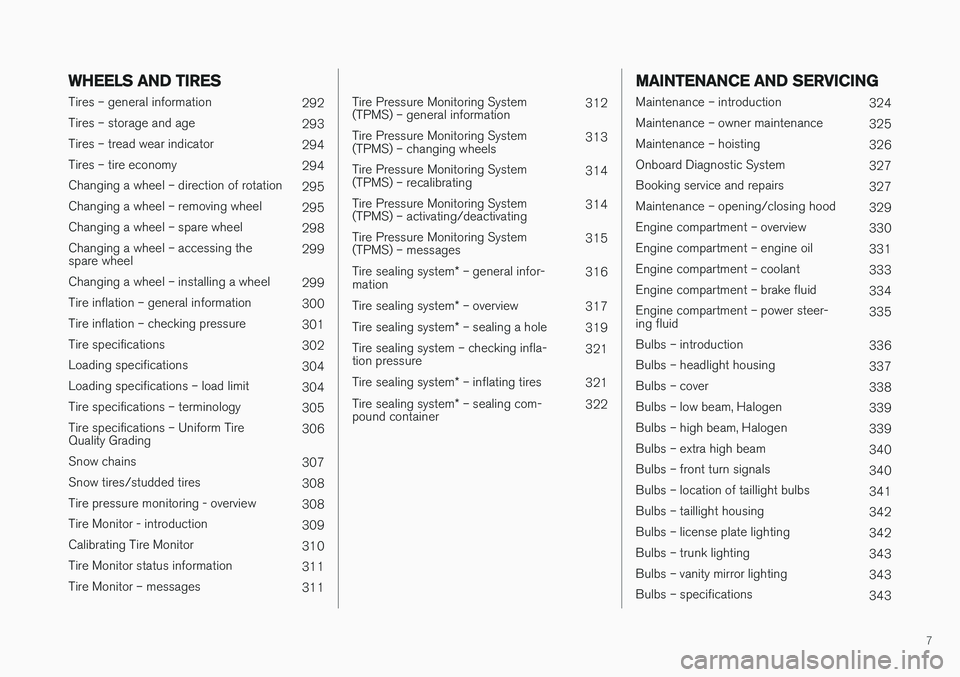
7
WHEELS AND TIRES
Tires – general information292
Tires – storage and age 293
Tires – tread wear indicator 294
Tires – tire economy 294
Changing a wheel – direction of rotation 295
Changing a wheel – removing wheel 295
Changing a wheel – spare wheel 298
Changing a wheel – accessing the spare wheel 299
Changing a wheel – installing a wheel 299
Tire inflation – general information 300
Tire inflation – checking pressure 301
Tire specifications 302
Loading specifications 304
Loading specifications – load limit 304
Tire specifications – terminology 305
Tire specifications – Uniform TireQuality Grading 306
Snow chains 307
Snow tires/studded tires 308
Tire pressure monitoring - overview 308
Tire Monitor - introduction 309
Calibrating Tire Monitor 310
Tire Monitor status information 311
Tire Monitor – messages 311
Tire Pressure Monitoring System (TPMS) – general information312
Tire Pressure Monitoring System(TPMS) – changing wheels 313
Tire Pressure Monitoring System(TPMS) – recalibrating 314
Tire Pressure Monitoring System(TPMS) – activating/deactivating 314
Tire Pressure Monitoring System(TPMS) – messages 315
Tire sealing system * – general infor-
mation 316
Tire sealing system * – overview
317
Tire sealing system * – sealing a hole
319
Tire sealing system – checking infla-tion pressure 321
Tire sealing system * – inflating tires
321
Tire sealing system * – sealing com-
pound container 322
MAINTENANCE AND SERVICING
Maintenance – introduction
324
Maintenance – owner maintenance 325
Maintenance – hoisting 326
Onboard Diagnostic System 327
Booking service and repairs 327
Maintenance – opening/closing hood 329
Engine compartment – overview 330
Engine compartment – engine oil 331
Engine compartment – coolant 333
Engine compartment – brake fluid 334
Engine compartment – power steer- ing fluid 335
Bulbs – introduction 336
Bulbs – headlight housing 337
Bulbs – cover 338
Bulbs – low beam, Halogen 339
Bulbs – high beam, Halogen 339
Bulbs – extra high beam 340
Bulbs – front turn signals 340
Bulbs – location of taillight bulbs 341
Bulbs – taillight housing 342
Bulbs – license plate lighting 342
Bulbs – trunk lighting 343
Bulbs – vanity mirror lighting 343
Bulbs – specifications 343
Page 64 of 398
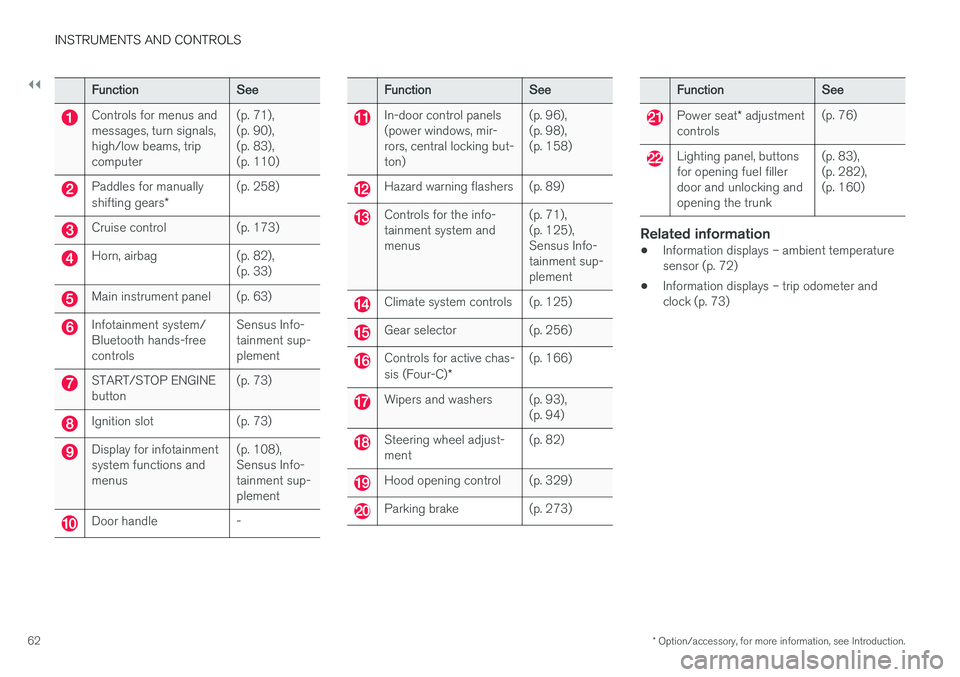
||
INSTRUMENTS AND CONTROLS
* Option/accessory, for more information, see Introduction.
62
FunctionSee
Controls for menus and messages, turn signals,high/low beams, tripcomputer(p. 71), (p. 90),(p. 83),(p. 110)
Paddles for manually shifting gears *(p. 258)
Cruise control(p. 173)
Horn, airbag(p. 82), (p. 33)
Main instrument panel(p. 63)
Infotainment system/ Bluetooth hands-freecontrolsSensus Info- tainment sup-plement
START/STOP ENGINE button(p. 73)
Ignition slot(p. 73)
Display for infotainment system functions andmenus(p. 108), Sensus Info-tainment sup-plement
Door handle-
FunctionSee
In-door control panels (power windows, mir-rors, central locking but-ton)(p. 96), (p. 98),(p. 158)
Hazard warning flashers(p. 89)
Controls for the info- tainment system andmenus(p. 71), (p. 125),Sensus Info-tainment sup-plement
Climate system controls(p. 125)
Gear selector(p. 256)
Controls for active chas- sis (Four-C)*(p. 166)
Wipers and washers(p. 93), (p. 94)
Steering wheel adjust- ment(p. 82)
Hood opening control(p. 329)
Parking brake(p. 273)
FunctionSee
Power seat* adjustment
controls(p. 76)
Lighting panel, buttons for opening fuel fillerdoor and unlocking andopening the trunk(p. 83), (p. 282),(p. 160)
Related information
• Information displays – ambient temperature sensor (p. 72)
• Information displays – trip odometer andclock (p. 73)
Page 69 of 398
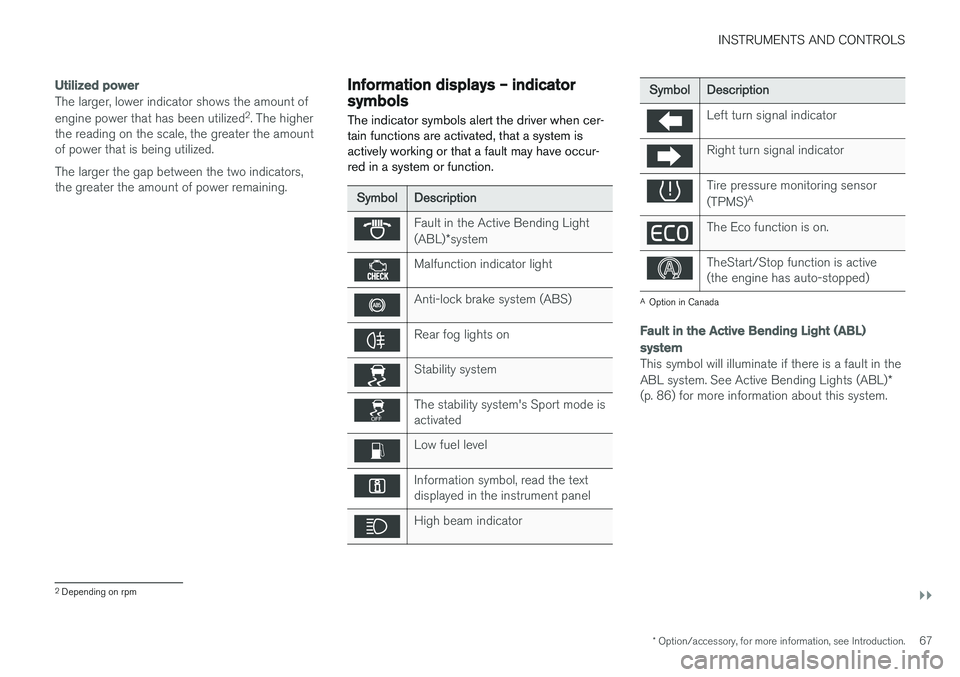
INSTRUMENTS AND CONTROLS
}}
* Option/accessory, for more information, see Introduction.67
Utilized power
The larger, lower indicator shows the amount of engine power that has been utilized2
. The higher
the reading on the scale, the greater the amount of power that is being utilized. The larger the gap between the two indicators, the greater the amount of power remaining.Information displays – indicator symbols
The indicator symbols alert the driver when cer- tain functions are activated, that a system isactively working or that a fault may have occur-red in a system or function.
SymbolDescription
Fault in the Active Bending Light (ABL) *system
Malfunction indicator light
Anti-lock brake system (ABS)
Rear fog lights on
Stability system
The stability system's Sport mode is activated
Low fuel level
Information symbol, read the text displayed in the instrument panel
High beam indicator
SymbolDescription
Left turn signal indicator
Right turn signal indicator
Tire pressure monitoring sensor (TPMS) A
The Eco function is on.
TheStart/Stop function is active (the engine has auto-stopped)
A
Option in Canada
Fault in the Active Bending Light (ABL)
system
This symbol will illuminate if there is a fault in the ABL system. See Active Bending Lights (ABL) *
(p. 86) for more information about this system.
2 Depending on rpm
Page 70 of 398
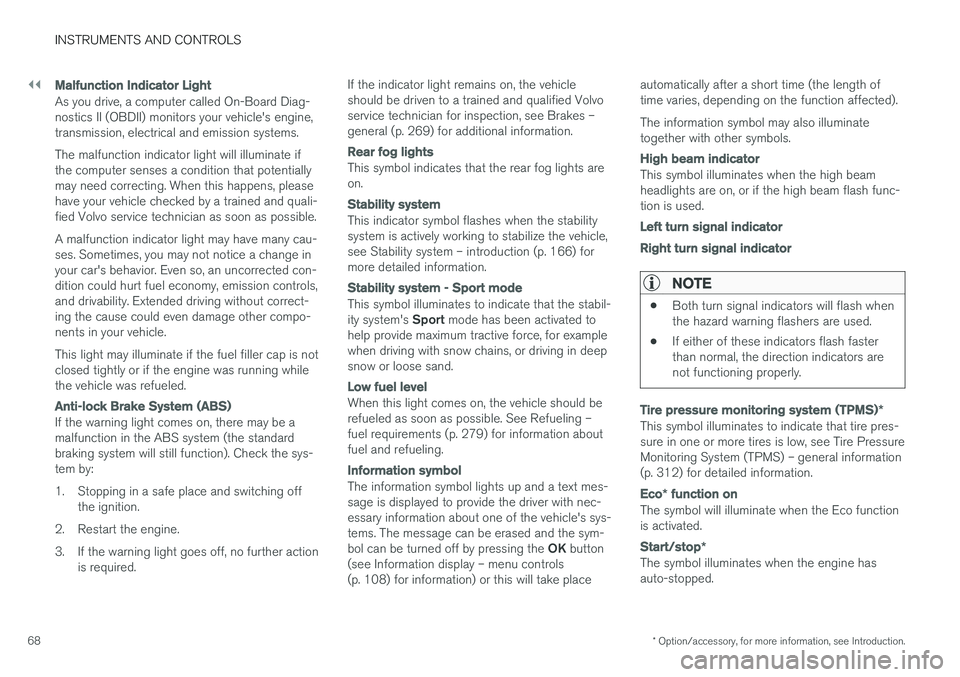
||
INSTRUMENTS AND CONTROLS
* Option/accessory, for more information, see Introduction.
68
Malfunction Indicator Light
As you drive, a computer called On-Board Diag- nostics II (OBDII) monitors your vehicle's engine,transmission, electrical and emission systems. The malfunction indicator light will illuminate if the computer senses a condition that potentiallymay need correcting. When this happens, pleasehave your vehicle checked by a trained and quali-fied Volvo service technician as soon as possible. A malfunction indicator light may have many cau- ses. Sometimes, you may not notice a change inyour car's behavior. Even so, an uncorrected con-dition could hurt fuel economy, emission controls,and drivability. Extended driving without correct-ing the cause could even damage other compo-nents in your vehicle. This light may illuminate if the fuel filler cap is not closed tightly or if the engine was running whilethe vehicle was refueled.
Anti-lock Brake System (ABS)
If the warning light comes on, there may be a malfunction in the ABS system (the standardbraking system will still function). Check the sys-tem by:
1. Stopping in a safe place and switching off
the ignition.
2. Restart the engine.
3. If the warning light goes off, no further action is required. If the indicator light remains on, the vehicle should be driven to a trained and qualified Volvoservice technician for inspection, see Brakes –general (p. 269) for additional information.
Rear fog lights
This symbol indicates that the rear fog lights are on.
Stability system
This indicator symbol flashes when the stability system is actively working to stabilize the vehicle,see Stability system – introduction (p. 166) formore detailed information.
Stability system - Sport mode
This symbol illuminates to indicate that the stabil- ity system's
Sport mode has been activated to
help provide maximum tractive force, for example when driving with snow chains, or driving in deepsnow or loose sand.
Low fuel level
When this light comes on, the vehicle should be refueled as soon as possible. See Refueling –fuel requirements (p. 279) for information aboutfuel and refueling.
Information symbol
The information symbol lights up and a text mes- sage is displayed to provide the driver with nec-essary information about one of the vehicle's sys-tems. The message can be erased and the sym- bol can be turned off by pressing the OK button
(see Information display – menu controls (p. 108) for information) or this will take place automatically after a short time (the length oftime varies, depending on the function affected). The information symbol may also illuminate together with other symbols.
High beam indicator
This symbol illuminates when the high beam headlights are on, or if the high beam flash func-tion is used.
Left turn signal indicator Right turn signal indicator
NOTE
•
Both turn signal indicators will flash when the hazard warning flashers are used.
• If either of these indicators flash fasterthan normal, the direction indicators arenot functioning properly.
Tire pressure monitoring system (TPMS)
*
This symbol illuminates to indicate that tire pres- sure in one or more tires is low, see Tire PressureMonitoring System (TPMS) – general information(p. 312) for detailed information.
Eco* function on
The symbol will illuminate when the Eco function is activated.
Start/stop *
The symbol illuminates when the engine has auto-stopped.
Page 85 of 398
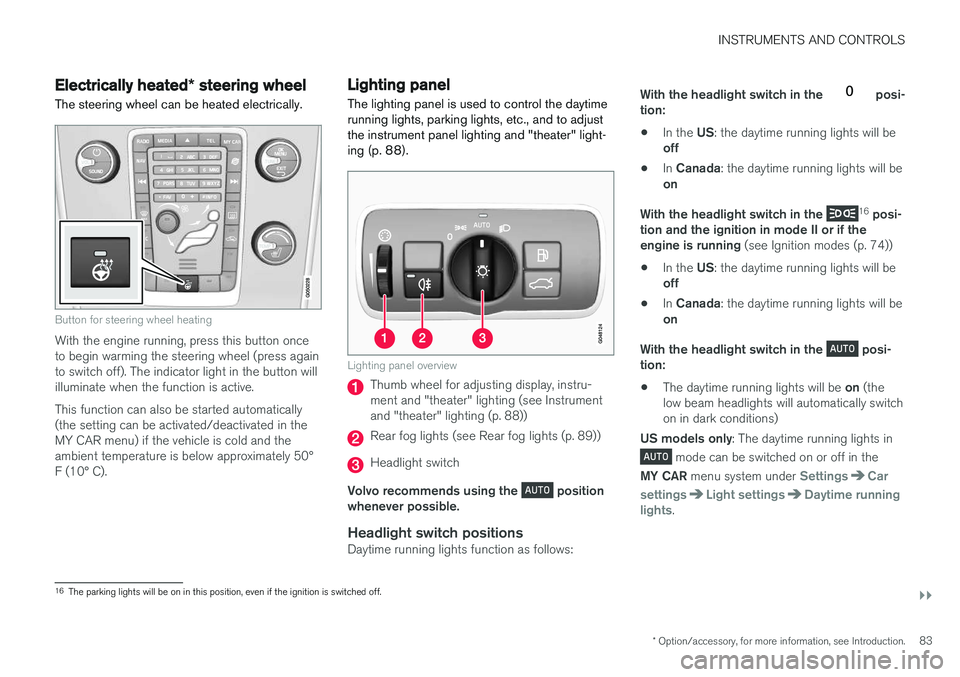
INSTRUMENTS AND CONTROLS
}}
* Option/accessory, for more information, see Introduction.83
Electrically heated* steering wheel
The steering wheel can be heated electrically.
Button for steering wheel heating
With the engine running, press this button once to begin warming the steering wheel (press againto switch off). The indicator light in the button willilluminate when the function is active. This function can also be started automatically (the setting can be activated/deactivated in theMY CAR menu) if the vehicle is cold and theambient temperature is below approximately 50°F (10° C).
Lighting panel The lighting panel is used to control the daytime running lights, parking lights, etc., and to adjustthe instrument panel lighting and "theater" light-ing (p. 88).
Lighting panel overview
Thumb wheel for adjusting display, instru- ment and "theater" lighting (see Instrumentand "theater" lighting (p. 88))
Rear fog lights (see Rear fog lights (p. 89))
Headlight switch
Volvo recommends using the
position
whenever possible.
Headlight switch positionsDaytime running lights function as follows: With the headlight switch in the
posi-
tion: • In the
US: the daytime running lights will be
off
• In
Canada : the daytime running lights will be
on
With the headlight switch in the
16
posi-
tion and the ignition in mode II or if the engine is running (see Ignition modes (p. 74))
• In the
US: the daytime running lights will be
off
• In
Canada : the daytime running lights will be
on
With the headlight switch in the
posi-
tion: • The daytime running lights will be
on (the
low beam headlights will automatically switch on in dark conditions)
US models only : The daytime running lights in
mode can be switched on or off in the
MY CAR menu system under
SettingsCar
settings
Light settingsDaytime running
lights.
16 The parking lights will be on in this position, even if the ignition is switched off.
Page 86 of 398

INSTRUMENTS AND CONTROLS
* Option/accessory, for more information, see Introduction.
84
NOTE
Volvo recommends the use of Daytime Run- ning Lights in the United States. The use of these lights is mandatory in Canada .
With the headlight switch in the posi-
tion: • The daytime running lights will be
off and the
low beam headlights will be on
High/low beam headlights
When the engine is started, the low beams are activated automatically if the headlight control is in position
.
Headlight switch and steering wheel lever
High beam flash
Toggle between high and low beams
Continuous high beam headlights
With the headlight switch in the (in dark
conditions only, when the daytime running lights have automatically switched off and the low beam headlights have switched on) or
position:
• Pull the lever toward the steering wheel to position 2 and release it to toggle betweenlow and high beams.
High beam flashPull the lever toward the steering wheel to posi-tion 1. The high beams come on until the lever isreleased.
Related information
•
Active Bending Lights (ABL)
* (p. 86)
• Active high beams (AHB)
* (p. 85)
• Lighting panel (p. 83)
• Tunnel detection (models with the rain sen- sor
* only) (p. 86)
Page 87 of 398
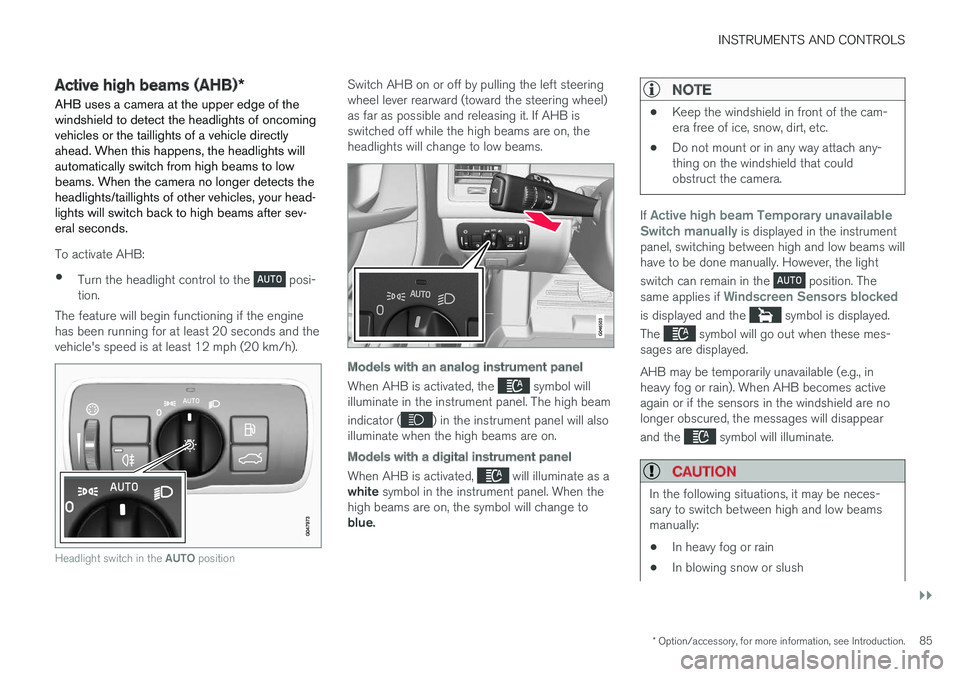
INSTRUMENTS AND CONTROLS
}}}}
* Option/accessory, for more information, see Introduction.85
Active high beams (AHB)*
AHB uses a camera at the upper edge of the windshield to detect the headlights of oncomingvehicles or the taillights of a vehicle directlyahead. When this happens, the headlights willautomatically switch from high beams to lowbeams. When the camera no longer detects theheadlights/taillights of other vehicles, your head-lights will switch back to high beams after sev-eral seconds.
To activate AHB:
• Turn the headlight control to the
posi-
tion.
The feature will begin functioning if the engine has been running for at least 20 seconds and thevehicle's speed is at least 12 mph (20 km/h).
Headlight switch in the AUTO position
Switch AHB on or off by pulling the left steering wheel lever rearward (toward the steering wheel)as far as possible and releasing it. If AHB isswitched off while the high beams are on, theheadlights will change to low beams.
Models with an analog instrument panel
When AHB is activated, the symbol will
illuminate in the instrument panel. The high beam indicator (
) in the instrument panel will also
illuminate when the high beams are on.
Models with a digital instrument panel
When AHB is activated, will illuminate as a
white symbol in the instrument panel. When the
high beams are on, the symbol will change to blue.
NOTE
• Keep the windshield in front of the cam- era free of ice, snow, dirt, etc.
• Do not mount or in any way attach any-thing on the windshield that couldobstruct the camera.
If Active high beam Temporary unavailable
Switch manually is displayed in the instrument
panel, switching between high and low beams will have to be done manually. However, the light switch can remain in the
position. The
same applies if Windscreen Sensors blocked
is displayed and the symbol is displayed.
The
symbol will go out when these mes-
sages are displayed. AHB may be temporarily unavailable (e.g., in heavy fog or rain). When AHB becomes activeagain or if the sensors in the windshield are nolonger obscured, the messages will disappear and the
symbol will illuminate.
CAUTION
In the following situations, it may be neces- sary to switch between high and low beamsmanually:
• In heavy fog or rain
• In blowing snow or slush
Page 89 of 398
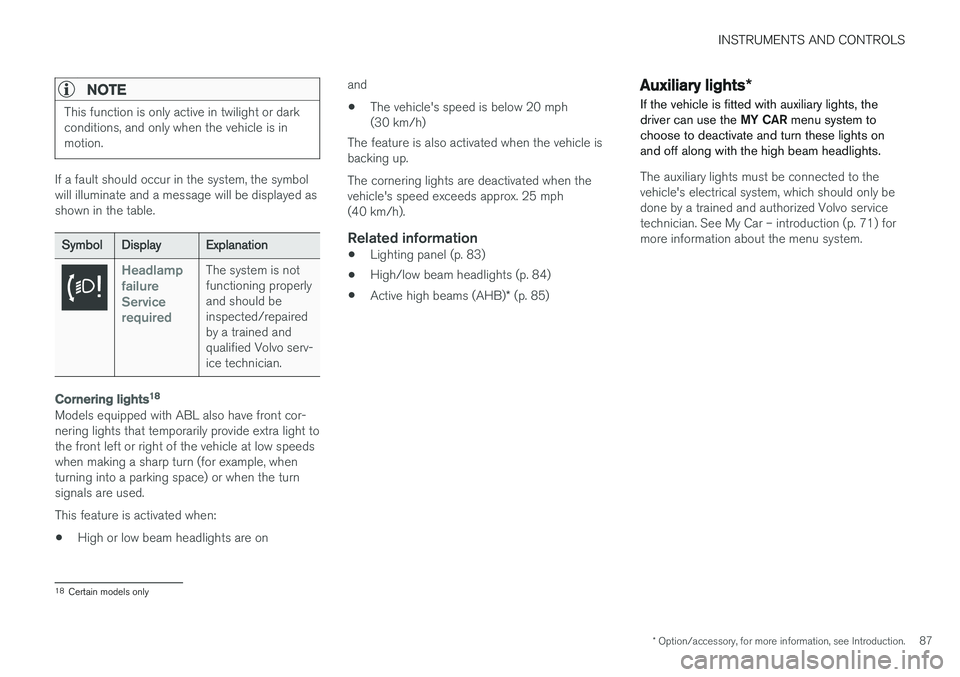
INSTRUMENTS AND CONTROLS
* Option/accessory, for more information, see Introduction.87
NOTE
This function is only active in twilight or dark conditions, and only when the vehicle is inmotion.
If a fault should occur in the system, the symbol will illuminate and a message will be displayed asshown in the table.
SymbolDisplayExplanation
Headlamp failureServicerequiredThe system is not functioning properlyand should beinspected/repairedby a trained andqualified Volvo serv-ice technician.
Cornering lights18
Models equipped with ABL also have front cor- nering lights that temporarily provide extra light tothe front left or right of the vehicle at low speedswhen making a sharp turn (for example, whenturning into a parking space) or when the turnsignals are used. This feature is activated when:
• High or low beam headlights are on and
• The vehicle's speed is below 20 mph (30 km/h)
The feature is also activated when the vehicle isbacking up. The cornering lights are deactivated when the vehicle's speed exceeds approx. 25 mph(40 km/h).
Related information
• Lighting panel (p. 83)
• High/low beam headlights (p. 84)
• Active high beams (AHB)
* (p. 85)
Auxiliary lights *
If the vehicle is fitted with auxiliary lights, the driver can use the MY CAR menu system to
choose to deactivate and turn these lights onand off along with the high beam headlights.
The auxiliary lights must be connected to the vehicle's electrical system, which should only bedone by a trained and authorized Volvo servicetechnician. See My Car – introduction (p. 71) formore information about the menu system.
18 Certain models only
Page 91 of 398
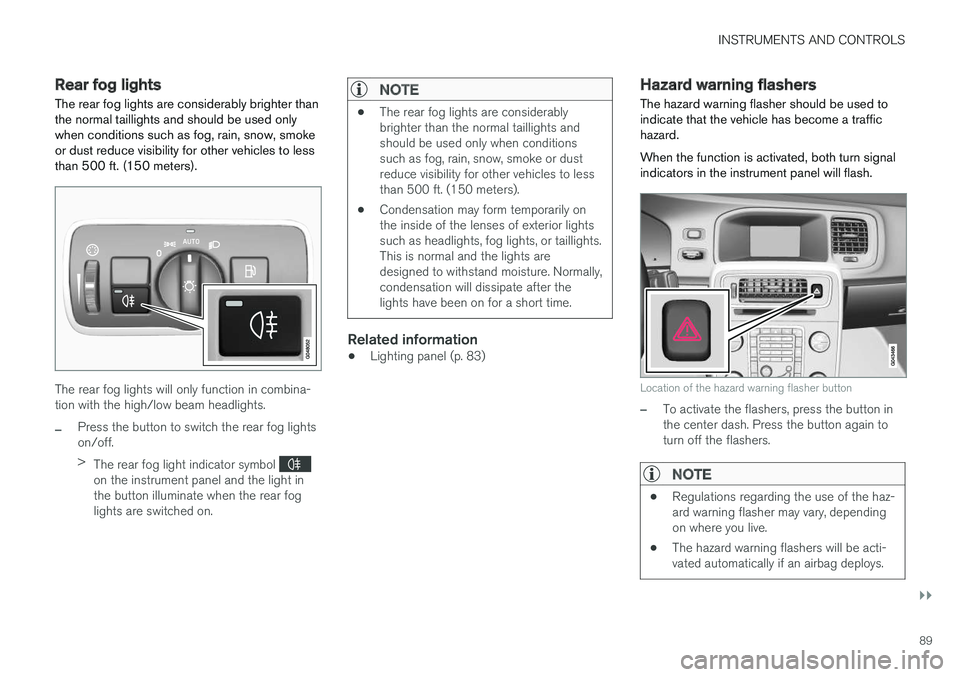
INSTRUMENTS AND CONTROLS
}}
89
Rear fog lights
The rear fog lights are considerably brighter than the normal taillights and should be used onlywhen conditions such as fog, rain, snow, smokeor dust reduce visibility for other vehicles to lessthan 500 ft. (150 meters).
The rear fog lights will only function in combina- tion with the high/low beam headlights.
–Press the button to switch the rear fog lights on/off. > The rear fog light indicator symbol
on the instrument panel and the light in the button illuminate when the rear foglights are switched on.
NOTE
• The rear fog lights are considerably brighter than the normal taillights andshould be used only when conditionssuch as fog, rain, snow, smoke or dustreduce visibility for other vehicles to lessthan 500 ft. (150 meters).
• Condensation may form temporarily onthe inside of the lenses of exterior lightssuch as headlights, fog lights, or taillights.This is normal and the lights aredesigned to withstand moisture. Normally,condensation will dissipate after thelights have been on for a short time.
Related information
•Lighting panel (p. 83)
Hazard warning flashers
The hazard warning flasher should be used to indicate that the vehicle has become a traffichazard. When the function is activated, both turn signal indicators in the instrument panel will flash.
Location of the hazard warning flasher button
–To activate the flashers, press the button in the center dash. Press the button again toturn off the flashers.
NOTE
• Regulations regarding the use of the haz- ard warning flasher may vary, dependingon where you live.
• The hazard warning flashers will be acti-vated automatically if an airbag deploys.